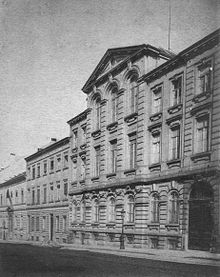Couvent des Dames de Berlaymont
The Berlaymont Monastery ( Couvent des Dames de Berlaymont ) in Brussels was founded in 1625 by Marguerite de Lalaing (1574–1650) with the support of her husband Florent de Berlaymont as a convent of the Augustinian women. After an expropriation, the canons established a new convent on Rue de la Loi in Brussels in 1864. In 1960 they sold the site to the Belgian state, which built the administrative building of the European Union here, which has since been called the Berlaymont building . The nuns moved to Argenteuil, a southern suburb of Brussels, and founded the new Berlaymont monastery.
founding
After dividing their property among their children, Marguerite and Florent got permission from Archduchess Isabella Clara Eugenia of Spain (1566–1633), governor of the Spanish Netherlands since 1621 , to run a monastery of the regular canons of St. Augustine in Brussels to found. They wanted to equip the monastery with their city palace near the Brussels Cathedral , which they had acquired from the t'Serclaes family, 100,000 florins for the construction of the church and a rent of 6,000 guilders in the form of land in Montigny, which they had bought from Floris had inherited from Montmorency, who was executed in 1570 on the orders of the Spanish King Philip II .
On December 18, 1624, the Archduchess approved the plan while the architect Jacques Francquart (1577–1651) was already at work. The Jesuit provincial Charles Scribani (1561-1629) drafted the monastery rule based on the Augustine rule with borrowings from Ignatius of Loyola . Pope Urban VIII confirmed the rule on August 10, 1626.
The first eight nuns went to retreat at Pentecost 1625 . The death of Florent de Berlaymont shortly thereafter delayed the official founding of the monastery until May 25, 1627, which took place in the presence of the Archduchess by Jacques Boonen, the Archbishop of Mechelen . The following year Marie de Duras was elected prioress.
The members of the monastery were initially divided into two classes, a regulation that was abandoned after half a century to simplify the recruitment of young people. One group were the canonesses, who had to be of aristocratic origin, while the other, middle-class group, as teachers (maîtresses des écollières), supported the canonesses in the education of middle-class girls.
Moves in the 19th and 20th centuries
In 1794, during the occupation of the Spanish Netherlands by revolutionary France, the nuns were forced into exile for the first time, four years later the monastery is permanently closed, the last nun left the monastery on May 31, 1798. Two months later the building was sold and then tore off.
A small boarding school survived the turmoil of the time, first in the Rue aux Laines, then in the former city palace of the Prince de Gavre in the Rue des Trois-Têtes. In 1808 the nuns stayed in the former Couvent des Minimes ( Paulaner ), which stood between the Rue de l'Etoile (Sterstraat), the Rue du Manège and the Rue de l'Arbre Bénit (Gewijde Boomstraat). Their neighbor, the Prince of Merode, gave them a part of his garden so that a new monastery could be built.
In 1864 the monastery had to move again because new streets such as the extension of the Rue de la Régence and the Rue Ernest Allard were to be built here in connection with the construction of the new Brussels Palace of Justice . Most of the garden used by the nuns became the square in front of the Palace of Justice. The convent moved to a more rural area, to Rue de la Loi, which was extended as a connection to the new military training area and a few years later to the jubilation park (Parc du Cinquantenaire, which was built on the 50th anniversary of Belgium's independence in 1880) ) should lead.
With the growth of Brussels, the Rue de la Loi developed from a rural to one of the new urban areas of the city, and became particularly interesting as a building site for office buildings. On December 8, 1958, the Belgian government offered to buy the property in order to build the administrative center of the European Union, the office building then known as the Berlaymont building. In addition to the purchase price, a (renewed) replacement site was to be made available, again on the outskirts of the city, this time in Argenteuil, a district of Waterloo, 15 kilometers south of Brussels . The purchase agreement was signed on May 25, 1960.
literature
- Thierry Demey: Bruxelles, capitale de l'Europe , Badeaux, Brussels 2007, pp. 226–233
